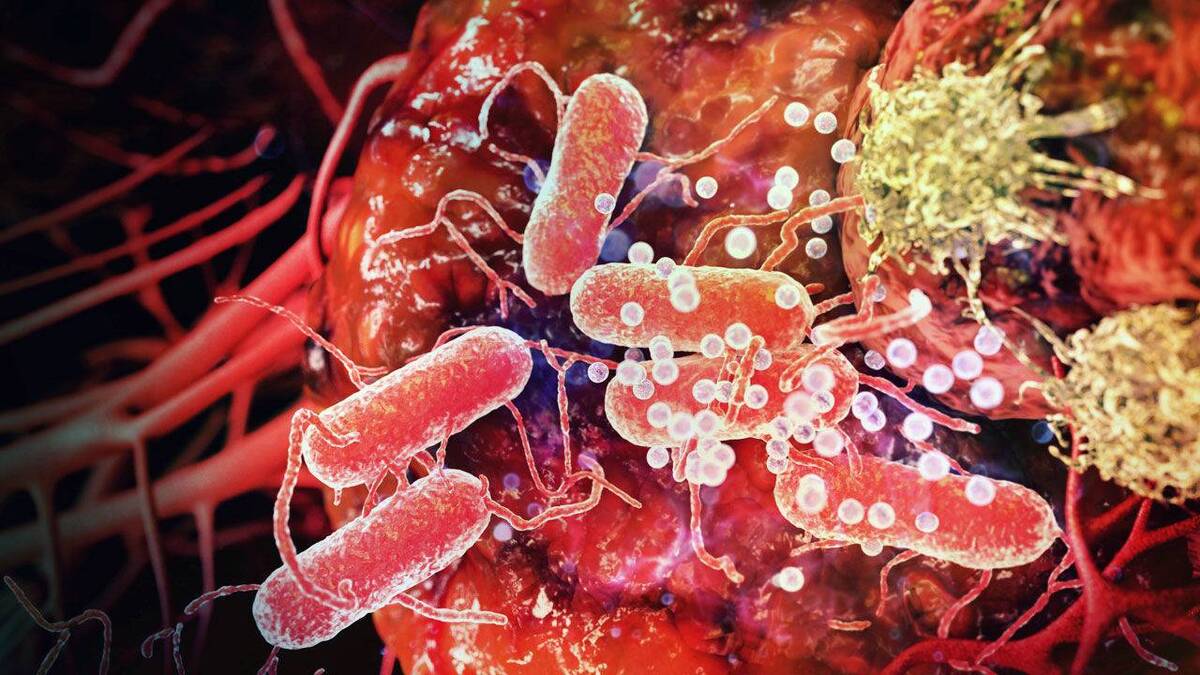Bacteria Found in Tumors Could Prove Potent Anticancer Tool

Cancer continues to be one of the leading causes of death worldwide. Although scientists have made notable progress in developing a range of successful therapies to treat many different types of cancer, improving safety, minimizing side effects, and lowering cost remain a driving force in the field, the journal Advanced Science reported.
An innovative area of research is looking to use bacteria as a therapeutic platform; specifically, bacteria that live inside tumors. “Tumor-resident microbiota — bacteria living inside tumors — have been documented for a variety of cancer types, though their biological function remains unclear,” explained Eijiro Miyako, associate professor at the Japan Advanced Institute of Science and Technology.
“In fact, bacteria was found in tumor tissue more than 100 years ago,” he continued. “However, due to the technical inability to exclude the possibility of contamination and the very low microbial content in tumors, the presence of these bacteria was not widely recognized and explored until now.”
Recent studies have identified the significant role that intratumoral bacteria play, not only in tumor development, but their affect on how well some cancer treatments work. However, an unexplored element, namely the role they might play in treating and destroying tumors themselves, intrigued Miyako who has been working in the field for the last ten years.
The journey to this discovery is a personal one for him. “My best friend’s death led me to this area of research,” he said. “My buddy had serious pancreatic cancer and there were very few options for him. His death left me completely devastated. It was then that I made up my mind to create a life-saving therapy for those suffering from cancer, like my friend.”
Bacteria in cancer therapy have been gaining attention in recent years due to some advantageous properties, such as their ability to specifically target tumors, deliver engineered therapeutics, move effectively within the body, activate the immune system, and act as drug carriers.
While promising, this is still a new area of discovery, and as such, there are hurdles to overcome, especially in terms of efficacy and overall safety. Mikayo and his collaborators believe that microbiota residing inside tumors may provide a more effective approach without requiring expensive genetic manipulation or nanoengineering.
“We are the first team to directly use isolated intratumoral bacteria for cancer treatment,” he said, referring to a recent study published in Advanced Science in which they explored the tumor-resident bacteria’s anticancer effects. “We recovered three types of bacteria from tumors: A-gyo (Proteus mirabilis), UN-gyo (Rhodopseudomonas palustris), and AUN (the [mixture] of A-gyo and UN-gyo).” The names were derived from the names of statues and elements of traditional Japanese culture.
The idea is to use the tumor-residing bacteria as a new type of immunotherapy by using them to activate the immune system to destroy tumors. The bacteria Mikayo and his team isolated preferentially grow within tumors because they thrive in hypoxic, or oxygen-deficient, environments, normally contributing to cancer development by initiating DNA mutation, activating carcinogenic pathways in the body, promoting chronic inflammation, and initiating the spread to other organs.
However, the scientists proposed harnessing them against the cancer. After the bacteria are injected, they would stimulate the body’s immune system to recognize and target them. Consequently, immune cells would then be able to infiltrate tumors in their quest to kill the bacteria that reside there, eliminating cancerous cells during the process.
In the current study, Mikayo and his collaborators explored their theory using mouse models of cancer, including colorectal cancer, sarcoma, metastatic lung cancer, and extensive drug-resistant breast cancer.
The team found that the three bacteria, AUN, A-gyo, and a combination of A-gyo and UN-gyo, achieved dramatic tumor suppression and complete response, where all detectable signs of the tumor disappeared, after a single-dose administration. “The tumors completely disappeared after [intravenous] injection of AUN, A-gyo, or A-gyo + UN-gyo, and provided an excellent prognosis with no recurrence after treatment,” they wrote in the paper.
The survival rate of mice after treatment with AUN or A-gyo was significantly prolonged compared to the control groups, with a 100% survival rate after 120 days. The researchers noted no significant weight loss in the treated mice, indicating low overall toxicity and minimal obvious side effects.
“The intratumoral bacteria were found to be superior than conventional remedies, especially in terms of anticancer efficacy, tumor targeting, independence from biomarkers, production cost, safety, and unnecessary of genetic engineering [in our models],” said Miyako.
“They exhibit unprecedented high efficacy just by single administration,” he added. “Other anticancer immunotherapies, including previous bacteria-based remedies, have not achieved the same strong efficacy. We could really revolutionize cancer therapy with this new microbial modality.”
The research team also explored a concept called immunological memory response, which refers to the ability of our immune system to “remember” and recognize past pathogens. They specifically wanted to test if the immune systems of mice who had been previously treated with the bacteria and recovered would shut down any tumor recurrence, even when injected again with tumor cells.
They found that in 100% of the previously treated mice, tumor regrowth was prevented by the anti-tumor immunity they had acquired. “More surprisingly, these treated mice were healthy, without tumor recurrence for more than 300 days in the experimental scheme, even after tumor rechallenge,” they wrote.
“I hope that someday, our bacterial therapy would be the fourth choice as an effective immunotherapy for cancer patients in addition to other conventional treatments such as surgery, chemotherapy, and radiation,” said Miyako.
But before this can happen, there are still hurdles to overcome. “The first is, frankly, safety,” said Miyako. “We confirmed high biocompatibility of these bacteria in our mouse experiments, but more tests are needed before clinical trials in humans can begin. I’m optimistic we can breakdown any barriers between us and human trials, just like the bacteria help break down the various tumors.”
4155/v





















